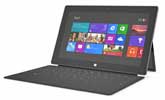Windows Surface tablets will be here shortly
Now this should be interesting. On October 16, 2012, Microsoft announced more detail on its upcoming Windows Surface tablets. And though labeled as a “pre-order” with limited amounts, customers could actually order the Windows Surface RT tablet of their choice from the Surface page on Microsoft’s online store. For delivery on or before October 26th, i.e. within ten days.
 So the pricing of the Microsoft Windows RT tablets is no longer a secret. The basic 32GB tablet without a keyboard touch cover is US$499, the touch cover adds a hundred bucks, and the 64GB version with touch cover is US$699. That gets you a Microsoft-branded tablet that’s as slender as the iPad, though it weighs a tiny bit more (1.5 vs 1.44 pounds). The Microsoft tablet looks wider because its 10.6-inch screen has a wide-format 16:9 aspect ratio compared to the iPad’s 4:3.
So the pricing of the Microsoft Windows RT tablets is no longer a secret. The basic 32GB tablet without a keyboard touch cover is US$499, the touch cover adds a hundred bucks, and the 64GB version with touch cover is US$699. That gets you a Microsoft-branded tablet that’s as slender as the iPad, though it weighs a tiny bit more (1.5 vs 1.44 pounds). The Microsoft tablet looks wider because its 10.6-inch screen has a wide-format 16:9 aspect ratio compared to the iPad’s 4:3.
There’s a standard USB port (which the iPad doesn’t have) and a standard microSD card slot (which the iPad also doesn’t have). There’s a capacitive touch screen of course, and two 720p cameras, meaning the Surface tablet is for video and not so much for taking pictures (for that you’d want higher res). The 1366 x 768 pixel resolution is more than the original iPad and the iPad 2’s 1024 x 768, and it’s also what’s called 720p in HDTV and video speak, so it should be good for video playback.
All the expected sensors are there: ambient light, accelerometer, gyroscope and compass, meaning the Surface will be able to do the same tricks customers have come to expect from modern apps. And speaking of apps, the Surface RT tablet comes with Microsoft Office Home and Student 2013 RT (see here). It’s not the final, final version, but it’ll be a free update when that becomes available.
There’s WiFi and Bluetooth, but no mobile broadband, so these initial versions of Microsoft’s RT Surface tablets will need to be within the reach of a WiFi access point to be online. The processor is of the Nvidia Tegra variety, i.e. the type that has been powering the majority of Android tablets out there.
What’s new and different is Windows RT, a version of Windows that runs on ARM processors and doesn’t need the presumably more complex x86-based hardware required to run full Windows. What exactly that means remains to be seen. It’s said that the Surface RT tablets are aimed at the consumer market, but the iPad was, too, and now it’s used almost everywhere. How exactly will Windows RT work? How will it resonate with customers who have come to expect elegant, effortless simplicity from tablets? No one knows just yet.
And how will it all relate to Surface tablets with full Windows 8, tablets that will, at least the Microsoft Surface versions, look very much like the Surface RT tablets, but have beefier hardware (anything from the latest Atom to third gen Core processors), higher resolution (1920 x 1080), and more storage? Will the two co-exist, with users selecting one or the other depending on their needs? The Windows 8 Pro versions will inevitably cost a good bit more, but how much more can a market bear where consumers have been spoiled with very inexpensive, very powerful notebook computers for years? Much will probably depend on how Windows 8 pans out.
Finally, what will it all mean to vertical and industrial market tablets? Will there be rugged tablets running Windows RT? Or will the ever-important leverage factor dictate that most enterprise and industrial tablets remain x86-based and compatible with legacy Windows? No one knows.
So for now I ordered a Surface RT tablet, just to see how it works and what it’s all about.